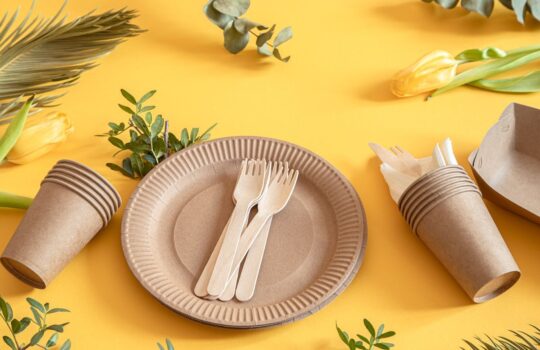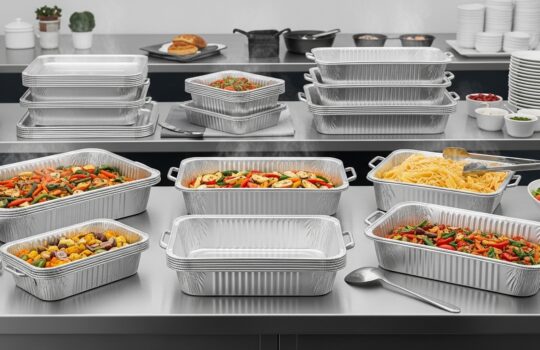Takeout and delivery have become a cornerstone of the food and hospitality industry’s revenue. Food-related disposables containers now make up over 60% of litter collected in environmental cleanups. This growing waste problem has put sustainability in the spotlight.
In response, restaurants and packaging suppliers embrace recyclable plastic clamshells as an eco-friendly solution. These containers retain the durability and cost-effectiveness of plastic while reducing environmental impact.
Below, we explore the sustainability trends fueling this shift, industry statistics, new regulations, and the key benefits of recyclable clamshell packaging.
Sustainability Trends Driving Sustainable Takeout Packaging Growth
Globally, the sustainable packaging market was valued over $270 billion in 2023 and is projected to grow 7.6% annually through 2030. Much of this momentum comes from rising awareness of packaging waste and its environmental impact.
Consumers increasingly prefer products and food delivered in environmentally responsible packaging. This preference influences brands to rethink their packaging choices to meet customer expectations and enhance their eco-conscious image.
Crucially, recyclable plastics are significantly contributing to these sustainability trends. Innovations in recycling technology and materials have made it possible to produce sturdy clamshell containers from recycled plastic that can be recycled after use.
The market for recycled plastic packaging is expanding rapidly. This reflects how companies worldwide are joining the push to minimize plastic pollution by using recycled content and designing packaging for recyclability.
In short, sustainable takeout packaging is no longer a trend but a mainstream movement, backed by market forces and consumer expectations that business owners can’t afford to ignore.
Regulations and Laws Pushing Recyclable Packaging Adoption
Government regulations are a major catalyst in the industry’s move toward recyclable packaging solutions. Across the globe, policymakers are introducing laws to curb single-use plastics and mandate more sustainable practices. These regulatory tailwinds make adopting recyclable plastic clamshells an ethical choice and often a compliance requirement.
Bans on polystyrene foam: One of the most significant regulatory trends is banning expanded polystyrene foam (EPS, also known as Styrofoam) for food containers. Once ubiquitous for their low cost, foam takeout clamshells are non-biodegradable and notoriously difficult to recycle, so they’ve become a prime target for lawmakers.
At least half a dozen US states and cities have outlawed foam food containers. For example, New York City banned single-use foam takeout containers in 2019, and states like Oregon and Rhode Island have recently implemented statewide bans. The direction is clear: the era of foam clamshells is ending, accelerating the rise of recyclable packaging.
In the next few years, compliance will likely require nothing less than fully recyclable or compostable packaging, so adopting recyclable clamshells today is also a smart form of future-proofing.
Benefits of Recyclable Plastic Clamshells for Businesses and Consumers
Choosing recyclable plastic clamshell containers for takeout and delivery offers many benefits. These modern containers help the environment, satisfy customers, and make good business sense.
Below we break down the key advantages that make recyclable clamshells an appealing solution for food and hospitality businesses:
-
- Cost-Effectiveness: Traditional plastic became ubiquitous in packaging because it’s inexpensive. Plastic clamshell containers remain one of the lowest-cost options compared to aluminum or compostable fiberalternatives. For budget-conscious restaurants, switching from foam to recyclable plastic can often be done without a significant cost increase, and in some cases with virtually no added cost. Durability and Performance: Recyclable plastic clamshells offer excellent durability and food protection, equal or superior to the packaging they replace. These containers are sturdy and leak-resistant, securely holding saucy, greasy, or heavy foods without collapsing. From a consumer perspective, the rigid structure keeps meals intact and presentable. Environmental Impact Reduction: The most obvious benefit of recyclable clamshells is the positive environmental impact. By using containers that can be recycled, businesses help ensure that fewer takeout boxes end up as litter in landfills or oceans. Instead of being trash after one use, the plastic can be collected, reprocessed, and made into new products. Many recyclable clamshells are now made with post-consumer recycled plastic, further amplifying the environmental benefit. Customer Appeal and Brand Image: Today’s consumers are not only aware of sustainability issues, many actively seek out businesses that align with their values. Offering eco-friendly, recyclable takeout containers sends a powerful message to customers that your business is committed to reducing its environmental impact. This can enhance your brand image and differentiate you in a crowded market. Diners increasingly feel guilt or frustration when faced with heaps of non-recyclable packaging; by contrast, they appreciate restaurants that make recycling or reusing packaging easy.
Real-World Examples: Sustainable Packaging in Action
Around the world, many food businesses have successfully transitioned to recyclable takeout packaging. These case studies and examples illustrate the tangible benefits and feasibility of making the switch, offering inspiration for others in the industry:
-
- City-Wide Change in San Francisco: One of the earliest and most notable examples is San Francisco’s 2007 Food Service Waste Reduction Ordinance, which required all restaurants to use only recyclable or compostable to-go containers. This bold move effectively eliminated Styrofoam clamshells in the city. In the years since, San Francisco’s eateries have managed the transition smoothly, using alternatives like recyclable plastic clamshells and compostable fiber boxes. The success of this city-wide mandate demonstrated that sustainable packaging can work on a large scale.
-
- Fast-Food Giants Eliminating Foam: On the corporate side, major fast-food chains have made highly visible commitments to sustainable packaging – validating that recyclable containers can meet the demands of high-volume operations. McDonald’s, for example, set a goal that by 2025, 100% of its guest packaging will come from renewable, recycled or certified sources. As a step toward that goal, McDonald’s announced it would eliminate all foam packaging from its worldwide system, which it achieved in 2018. Notably, McDonald’s reported that sustainable packaging initiatives also helped the bottom line: the company’s initial efforts to reduce packaging waste (dating back to a collaboration with Environmental Defense Fund in the 1990s) saved the company an estimated $6 million.
-
- Innovative Reusable Programs (a Glimpse of the Future): While not the focus of this article, it’s worth noting that some businesses are moving beyond single-use recyclables toward reusable container models. For example, universities and startups have introduced reusable clamshell container programs (like OZZI containers or DeliverZero in New York), where customers return the durable containers for washing and reuse. Each reusable clamshell can replace hundreds of disposable ones over its lifetime. Still in early adoption, these programs show the appetite for sustainable solutions.
These examples demonstrate that shifting to recyclable takeout packaging is both achievable and beneficial. Businesses that have made the change often report minimal drawbacks and significant upsides, such as improved customer perception, easier compliance with laws, and sometimes even cost savings or operational efficiencies.
Embracing a Sustainable Packaging Future
The drive toward recyclable plastic clamshells in takeout packaging is more than a trend. Once a nice-to-have, sustainability is a strategic imperative fueled by consumer demand, environmental urgency, and increasing regulatory requirements.
This shift allows business owners to align environmental responsibility with operational benefits. By transitioning to recyclable takeout containers, restaurants and cafes can reduce waste, comply with laws, and delight eco-conscious customers, all while maintaining the practical performance that food packaging requires.
With plenty of success stories to emulate and support from innovative packaging partners, making the sustainable switch is easier and more advantageous than ever. Doing so lets you position your business as a sustainability leader, delight customers, and contribute to a cleaner planet.
FAQs
1. Why are recyclable plastic clamshells better than traditional foam containers?
Recyclable plastic clamshells offer the same durability and leak resistance as foam containers but are environmentally friendly and legally compliant. Many governments are banning foam due to its non-recyclable nature, while recyclable plastics can be reused in the manufacturing cycle, reducing waste and pollution.
2. What types of plastic are used in recyclable clamshells?
Most recyclable plastic clamshells are made from rPET (#1 PET) or polypropylene (#5 PP). Recycling facilities widely accept these materials, ensuring they don’t end up in landfills. Some are also made from post-consumer recycled plastic, reducing their carbon footprint.
3. Are recyclable plastic clamshells more expensive than traditional packaging?
Not necessarily. While recyclable materials were once more expensive, market demand and improved production processes have lowered costs. In some cases, recyclable plastic containers cost the same as, or even less than, alternative materials. Plus, businesses save money in the long run by avoiding potential fines from non-compliance with packaging laws.
4. Can customers recycle these containers at home?
Yes, as long as the local recycling program accepts PET (#1) or PP (#5) plastics. Businesses need to educate customers by labeling containers with recycling symbols and providing guidance on recycling properly.
5. How do recyclable plastic clamshells help reduce environmental impact?
These containers are designed for a closed-loop recycling system, meaning they can be remanufactured into new products rather than becoming waste. Compared to using virgin plastic, this reduces plastic pollution, conserves natural resources, and minimizes carbon emissions.






